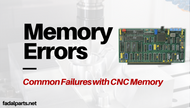CNC Memory Errors
Published by VMC Electric on Dec 16th 2018
CNC Memory Errors - The CNC memory uses a "checksum" method to verify the integrity. If the memory becomes corrupted (fails a checksum test), the "memory error" message is displayed. One of the most common reasons for this is the battery on the 1400 CPU board is failing. The battery backup design uses a combination of a capacitor and a battery to maintain the memory after the power is off. The picture above shows the purple battery and the blue capacitor. The capacitor does most of the work; it was designed to last approximately 3 days. The battery power switches in after that point.
Even though the battery might measure 5 VDC, it's only under a load that the battery can be properly tested to see what voltage it can hold when under the load from the memory chips. Dropping below 3.5 volts for 100 nanoseconds will cause a memory corruption.
Many different CNC problems can happen if the memory does becomes corrupted. It depends on the area of memory that has been corrupted. Sometimes the keyboard will even quit responding until you zero memory.
In most cases the battery and capacitor simply needs replacing.
You can usually recover temporally by zeroing the CNC memory using the control diagnostics. Be sure to try and save your program, offset and record the machine parameters (SETP) before zeroing all the memory because you'll need to restore them after zeroing all of the control memory. Leave the control power on and push in the E-stop button instead of powering off the machine. This will prove the battery or the switching circuitry is faulty.
History: The first CNC made at Fadal was using "Bubble Memory".
Non-volatile memory composed with a thin layer of material that can be magnetized in only one direction. When a magnetic field is applied to a circular area of this substance that is not magnetized in the same direction, the area is reduced to a smaller circle, or bubble. During the first stages in the 1960's while bubble memory was released it was widely believed that it would become one of the leading memory technologies, but these promises never were fulfilled. Other non-volatile memory types, such as eeprom is faster and less expensive.
It was popular for other machine tools at the time such as Fanuc, but for our applications, it was very slow and expensive. The bubble memory development at Fadal was abandoned and the battery back memory replaced it with the introduction of the VMC 40 in 1984...

